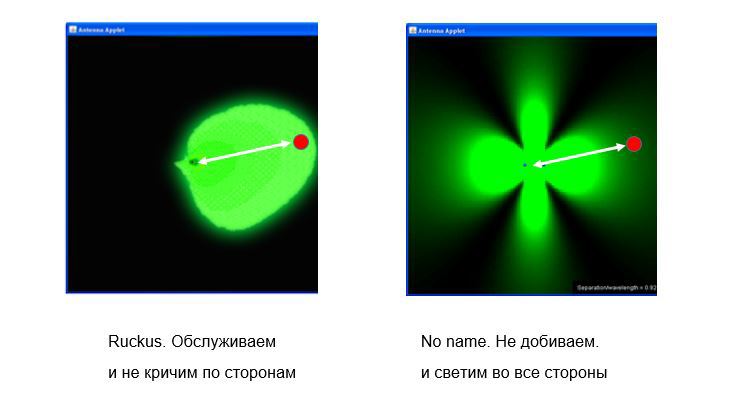WiFi from Ruckus - why is it the best
Each manufacturer of WiFi equipment praises itself, giving different arguments. But only a few really have something to brag about. Ruckus is one of those. Seriously, no manufacturer can control the directional pattern as much as they do. But first things first.

What is the dog buried here?
')

By the way, this is the official logo of the manufacturer Ruckus Wireless
For comparison, let's open the usual WiFi access point of the modern 802.11n standard. It will probably have two (sometimes three) MIMO antennas, which form waves that create a local maximum of radiation at the point of the space where the subscriber is located.

Hooray. Received twice as much signal. What is actually provided by the standard 802.11n. But! The same local maxima are formed in other points of space where there is no client. And not only in one plane, as shown in the picture, but in many planes. What for? As radio operators say, we warm the air. In addition, we interfere with other access points and other clients.
What did Ruckus do?
He created an antenna system that sends the antenna pattern of the access point directly to the client - see the topmost photo. At the access point there are several antennas for each range (and in two planes - vertical and horizontal). Some access point models have up to 20 antennas. Thanks to this, hundreds of radiation patterns are preset and recorded in the device library and, depending on the location of the client, the best combination of antenna operation is selected. That is, the access point constantly "looks" at the subscriber and sends him an individual packet. The next client is another package. And so on. The technology is called BeamFlex. The processor should be noted to be very productive. What is actually implemented at the access point.

Flagship access point - ZoneFlex R700 in the clear. We see as many as 6 antenna systems in which there are a total of 21 antennas. As a result, 3 streams are formed in two 2.4 and 5 GHz bands.
As a result, we obtain a signal gain towards the subscriber up to 9 dB and a weakening effect from other access points - up to 17 dB.

Interesting "house" sector antenna 120 degrees street access point:

But a special access point for stadiums with a beam of 30 x 30 degrees. No one has this at all, so most stadiums in the world use Ruckus for WiFi coverage:

Visualization of the pattern of the access point of the Ruckus and the normal access point

BeamFlex is not the only Ruckus Wireless technology that allows you to achieve high-quality reception and transmission, but the main one that allows you to say without blushing: Ruckus WiFi is the best
PS By the way, the antenna system of access points Ruckus (headquartered in sunny California) was developed and made by our compatriot Victor Shtrom from Zelenograd.

What is the dog buried here?
')

By the way, this is the official logo of the manufacturer Ruckus Wireless
For comparison, let's open the usual WiFi access point of the modern 802.11n standard. It will probably have two (sometimes three) MIMO antennas, which form waves that create a local maximum of radiation at the point of the space where the subscriber is located.

Hooray. Received twice as much signal. What is actually provided by the standard 802.11n. But! The same local maxima are formed in other points of space where there is no client. And not only in one plane, as shown in the picture, but in many planes. What for? As radio operators say, we warm the air. In addition, we interfere with other access points and other clients.
What did Ruckus do?
He created an antenna system that sends the antenna pattern of the access point directly to the client - see the topmost photo. At the access point there are several antennas for each range (and in two planes - vertical and horizontal). Some access point models have up to 20 antennas. Thanks to this, hundreds of radiation patterns are preset and recorded in the device library and, depending on the location of the client, the best combination of antenna operation is selected. That is, the access point constantly "looks" at the subscriber and sends him an individual packet. The next client is another package. And so on. The technology is called BeamFlex. The processor should be noted to be very productive. What is actually implemented at the access point.

Flagship access point - ZoneFlex R700 in the clear. We see as many as 6 antenna systems in which there are a total of 21 antennas. As a result, 3 streams are formed in two 2.4 and 5 GHz bands.
As a result, we obtain a signal gain towards the subscriber up to 9 dB and a weakening effect from other access points - up to 17 dB.

Interesting "house" sector antenna 120 degrees street access point:

But a special access point for stadiums with a beam of 30 x 30 degrees. No one has this at all, so most stadiums in the world use Ruckus for WiFi coverage:

Visualization of the pattern of the access point of the Ruckus and the normal access point
BeamFlex is not the only Ruckus Wireless technology that allows you to achieve high-quality reception and transmission, but the main one that allows you to say without blushing: Ruckus WiFi is the best
PS By the way, the antenna system of access points Ruckus (headquartered in sunny California) was developed and made by our compatriot Victor Shtrom from Zelenograd.
Source: https://habr.com/ru/post/243681/
All Articles